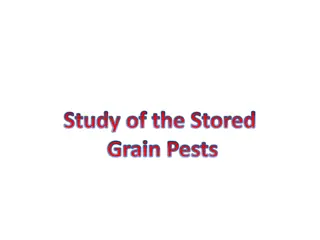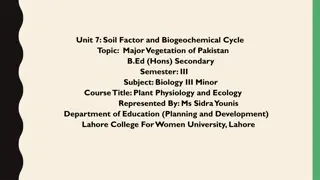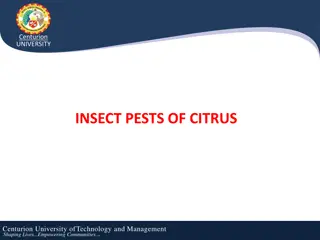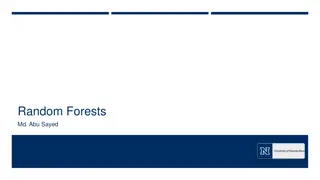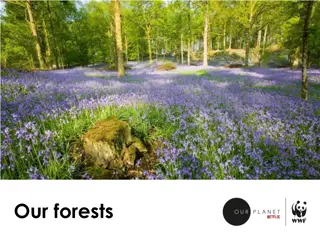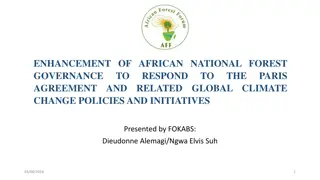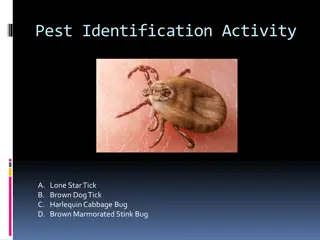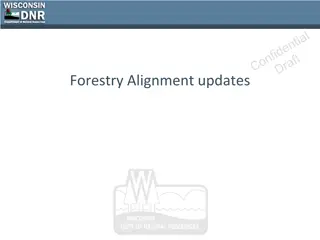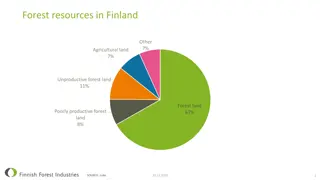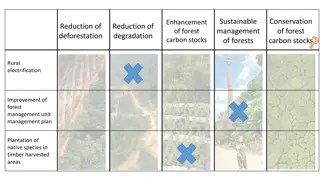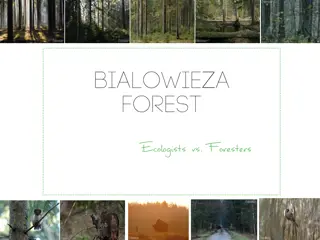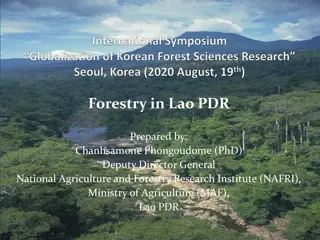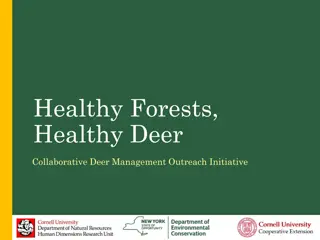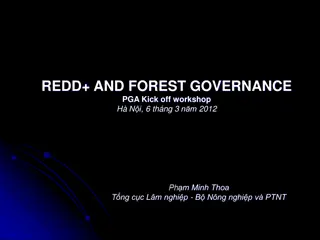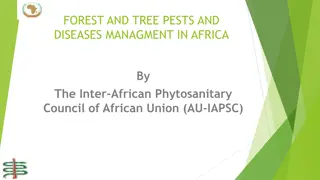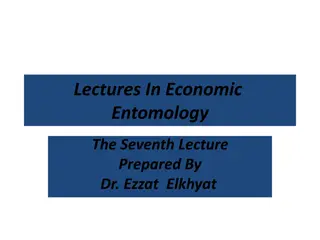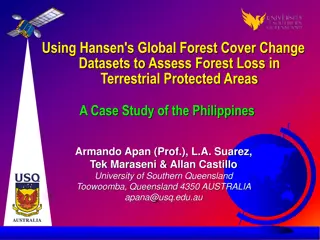Update on Forest Pests Impacting Northern CA National Forests
Regional entomologist Sheri Smith provides insights on the devastating impact of forest pests on Northern CA National Forests, including tree mortality rates, drought conditions, bark beetle attacks, and the vulnerability of trees to various stress factors, with a highlight on the significant tree death toll in the San Bernardino National Forest in 2003.
Uploaded on Sep 11, 2024 | 0 Views
Download Presentation

Please find below an Image/Link to download the presentation.
The content on the website is provided AS IS for your information and personal use only. It may not be sold, licensed, or shared on other websites without obtaining consent from the author. Download presentation by click this link. If you encounter any issues during the download, it is possible that the publisher has removed the file from their server.
E N D
Presentation Transcript
Sheri Smith Regional Entomologist Update on Forest Pests
Overlooked? Noticed!
Tree mortality on 12 Northern CA National Forests 7000000 1 0.5 6000000 0 Number of trees 5000000 Incipient Drought -0.5 PDI Value 4000000 -1 Mild Drought 3000000 -1.5 2000000 -2 Moderate Drought 1000000 -2.5 0 -3 1975 1976 1977 1978 1979 San Bernardino NF PDI Zone 6 4 600000 3 500000 2 PDI value Acres with mortality 1 400000 0 -1 300000 Mild drought -2 Moderate drought 200000 -3 Severe drought -4 100000 Extreme drought -5 -6 0 1998 1999 2000 2001 2002 2003 2004 2005 2006 2007 2008 FHP aerial survey data
2003 San Bernardino NF ~3.5 million trees killed 39% mortality of white fir 23% mortality of pines (Walker et al. 2005)
Tree Health Increased moisture stress = reduced photosynthesis = reduced growth and defenses = increase susceptibility to bark beetle attacks Drought thresholds for Jeffrey pine and ponderosa pine 80% of normal precipitation = chronic moisture stress 60% of normal precipitation = acute moisture stress Moisture stress can make trees more vulnerable to freeze injury. Increased injury from disease infections.
Bark Beetles Primary tree killers in CA Jeffrey pine beetle Mountain pine beetle Western pine beetle Fir engraver beetle Fir engraver beetle
Survey Highlights Over 45 million acres flown in CA ~3 million acres of forested lands with elevated levels of tree mortality (~900,000 acres in 2014) ~33 million acres of forested land, ~10% affected ~29 million dead trees detected (~3.3 million in 2014) pines, fir, incense cedar, Douglas-fir, oaks
Increases in whitebark pine mortality on the Klamath NF Increases in ponderosa pine mortality on the Shasta-T and Mendocino NFs (wpb/ips) Increases in pine mortality at lower elevation, west side locations on the Plumas, Lassen and Tahoe, NFs Increase in pine mortality on the Doublehead and Devil s Garden RDs, Modoc NF Higher levels of white fir mortality on the Lassen and Modoc NFs More mortality is previous fires (Chips; Barry Point)
Stanislaus and Eldorado NFs Ponderosa pine is increasing but not yet to the levels detected on the Sierra and Sequoia NFs. Group kills of pines (50 trees +) in mature pine plantations/dry foothill sites ~ <5000 ft. elevation. Sugar and ponderosa pines of all sizes in moderately burned areas in the Rim Fire (2013) have been attacked and killed by bark beetles. Several communities and public utility companies (Groveland, Twain Harte, Pinecrest, Arnold, Hathaway Pines, Dorrington, Amador, Pioneer, and others) are removing hazard trees.
Sierra NF Plot inventories (High Sierra RD) 49% of ponderosa pine forests have >50% mortality 17% mortality in mixed conifer/pine types High losses of overstory trees 51% pp; 27% wf; 17% sp ~30% additional mortality in the Aspen (2013) and French (2014) fires. Source: Ramiro Rojas <5,000 ft. elevation highest levels of mortality Mariposa and surrounding communities over 50% of ponderosa pines are dead - trending to 75% and higher.
Approximately 60% of all measured sugar and ponderosa pines over >15 DBH are dead. Dead trees across the Dinkey CFLR > 15 is ~1 million. >50% dead in pine type = ~7,500 acres (CFLR) >50% dead in Sierra mix conifer type = ~6,100 acres Dead trees across the Sierra NF > 15 DBH ~ 8 million. ~1/3 of the pine and mixed pine and fir have >50% mortality across the forest. More than 340 million board feet dead in the Dinkey CFLR and more than 1 billion board feet across the Forest. Based on 258 plots within the CLFR Ramiro Rojas
Bass Lake (w/i boundary of Sierra NF) high levels of mortality of overstory pines in campgrounds and in communities around the lake.
pine mortality, lower elevations, Sequoia NF colors enhanced to improve distinction between green and dead trees
Sequoia NF Piute and Greenhorn Mtns CA flatheaded borers and pine engraver beetles are killing Jeffrey pines (some JPB). MPB is killing large groups of mature sugar pines (RTB also). Mortality of incense cedar has increased large groups are dead on hillsides, in campground and along roads.
Ground Surveys - preliminary results Bark beetle species Tree count California fivespined ips Western pine beetle 1,522 583 Fir engraver 68 Jeffrey pine beetle 50 Pinyon ips Orthtomicus sabinana 11 4 Bark beetle species surveyed: 6 species identified Mean percent tree mortality in stands with injury 44% of the stand density killed 49% of the stand basal area killed Tom Coleman, unpublished
Others <5,000 ft. elevation many oaks (blue, interior, canyon live oak) showing drought stress Early leaf drop Branch dieback incense cedars are shedding older needles manzanita and white thorn are dying knobcone pine large natural stands killed by pine engraver beetles gray pine mortality has been increasing for several years. white fir mortality not as high as expected (yet). pinyon pine large scale die-offs (Inyo, Sequoia, LP) See poster for other updates on invasive agents (SOD, GSOB, etc.).
KEY POINTS Native bark beetles are a major cause of tree mortality in California. When, where, and the extent to which mortality occurs is influenced by forest stand conditions and weather patterns. ~ 29 million dead trees were detected this year. Governor Brown has declared a state of emergency associated with bark beetle activity and dead trees. High levels of tree mortality are occurring in mature trees. Hazard tree abatement activities are being planned and are ongoing in many locations. Elevated levels of tree mortality from bark beetles should be expected for several more years. Land managers are encouraged to limit the build-up of green slash or smaller diameter green trees in harvesting areas to lower the likelihood of pine engraver beetles killing residual standing trees. Extreme caution should be taken during prescribed fire treatments to greatly limit fire-injury on desired residual trees. High value trees in campgrounds (and known rust-resistance sugar pine trees, etc.) should be monitored closely for bark beetle activity and may require preventive treatments. Fire-injured trees in recently burned areas are at a higher risk of mortality than would be expected under more normal precipitation conditions. Changes to fuels and fuel loading - needle retention times, etc. More information is available for specific areas of interest.
http://www.fs.usda.gov/main/r5/forest-grasslandhealth http://foresthealth.fs.usda.gov/fhas
Acknowledgements Forest Health Protection Entomologists and Pathologists Jeff Moore, Aerial Survey Program Manager Ramiro Rojas District Silviculturist, High Sierra RD, Sierra NF Contractors - Amy Jirka, Loren McAffee and Adam Ellis Plane and Pilots Susanville Aviation, Steve Datema, George Mahon, John Litton Other Surveyors Zachary Heath R6, Kathleen Mathews and Chad Nelson R4 CALFIRE Forest Health Specialists USDA is an equal opportunity employer and provider.



